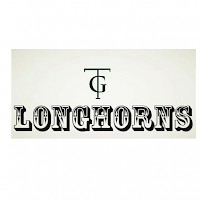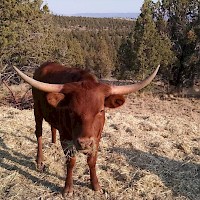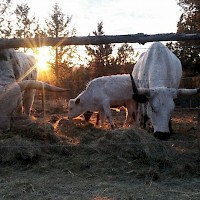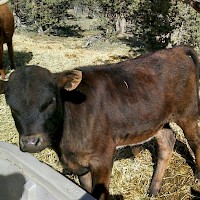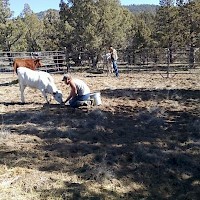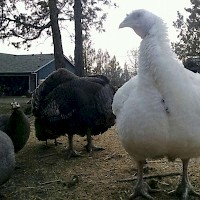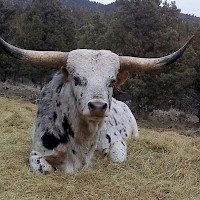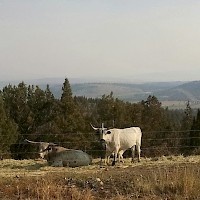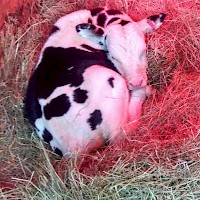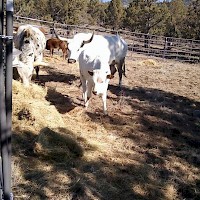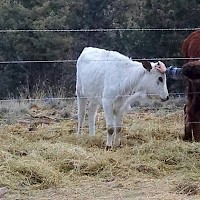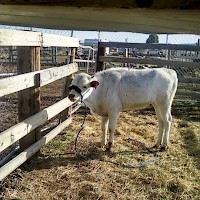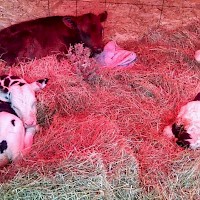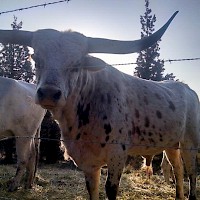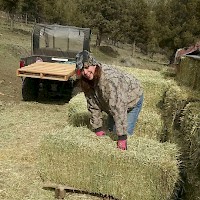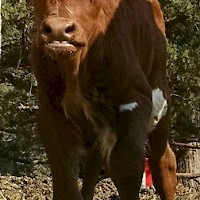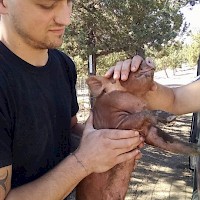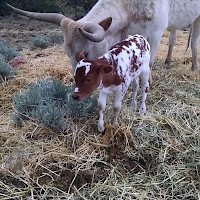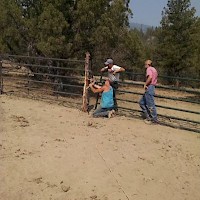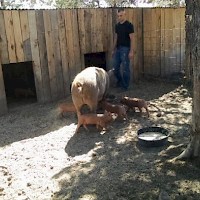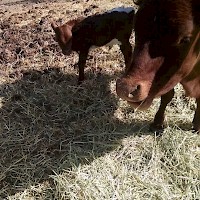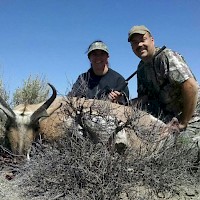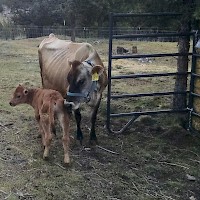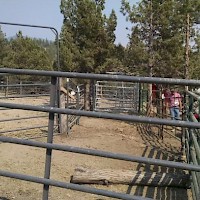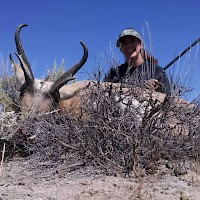
About TandG Longhorns:
T & G Longhorns
Our farm was established in 2013. Before he passed away in 2013 Travis's father helped us with getting started. With the assistance for the down payment, we purchased our property. We are located in the high desert of beautiful Central Oregon, just north of Prineville. When we made the decision to turn our property into a farm, we started with asking ouselves what kind of animals do we want to raise and how many do we want.?
Being in the high desert, which is cattle and farming country, we decided we did not want to be the same as everyone else. When you drive down the highway in Central Oregon you basically see two colors and three breeds in our area. They are black (Black Angus) or red (Red Angus or Hereford). We wanted something a little bit out of the ordinary and something that had some history to it. At that point we decided we couldn't be much more historic than the Longhorn. We started with a single bull (Victor) and cow (Victoria).
From there we expanded and began purchasing additional heifers and cows. At this point we are at 10 head, which is a perfect number for us to maintain.
When we decided to start raising the Longhorn Cattle, we also decided to raise pigs as well. Once again, we decided to be a little different. When we go to the fair we see all kinds of pink pigs, black pigs and blue butts. Gina decided she wanted a red colored pig. I thought she would like a Duroc, but when she saw the pictures she said those weren't the ones either.
At that point she began searching the internet and finally found Tamworth's. The Tamworth is another animal with a great long history. They are one of the oldest breeds of pigs and originate in the U.K.. The Tamworths are listed as "Threatened" in the United States and "Vulnerable" in the U.K..
We also decided we wanted rabbits, chickens, turkeys and quail. As with the Longhorns and Tamworths we decided to be a little different once again. For rabbits we went with the Satin breed. For chickens we have several different breeds. We have the basic White Leghorns, Americauna's, Chocolate Speckeld Sussex, Red Sexlink and our unique breed the Black Copper Marans. Just like the Tamworth Pigs the Black Copper Marans are becoming more and more rare.
HISTORY OF THE TEXAS LONGHORN
The Texas Longhorn became the foundation of the American cattle industry by claiming first rights in the untamed, newly discovered Americas a little over 500 years ago. In 1493, Christopher Columbus brought Spanish cattle to Santa Domingo, and within two hundred years their descendents would be grazing the ranges of Mexico.
In 1690, the first herd of cattle, only about 200 head, were driven northward from Mexico to a mission near the Sabine River-a land that would become known as Texas. The early missions and ranchers would not survive all of the elements. But the Texas Longhorn would. By the time of the Civil War, nearly 300 years after setting foot in America, millions of Longhorns ranged between the mesquite-dotted sandy banks of the Rio Bravo to the sandbeds of the Sabine. Most of the Longhorns were unbranded, survivors of Indian raids, scattered by stampedes and weather, escaped from missions or abandoned after ranch failures.
The survivors of the Civil War returned home to Texas to find abandoned ranches, unplowed farm fields—and herds of wild cattle, which would soon become gold in their pockets. In the next quarter century, 10 million head were trailed North to fatten on lush Midwestern grasses or shipped directly by rail to the beef-hungry East.
Translating wild cattle into hard cash was an epic struggle between man, beast and the elements—from this grew the romantic legends of the Western Cowboy.
Longhorns, groomed by Mother Nature, carried the ideal characteristics of resistance-they were tremendous for long drives. They could go incredible distances without water, rustle their own food, fend for themselves, swim rivers, survive the desert sun and winter snow. But, at the turn of the century, sundown came for the Texas Longhorn. It took less than 40 years, fenced in land, plows and an overwhelming demand in the marketplace to drive the Longhorn closer to extinction than the buffalo.
In 1927, the Federal government helped to preserve the Texas Longhorn and a great part of our American heritage. With only a handful of Texas Longhorns roaming the ranges in private herds, Congress appropriated $3,000, and assigned forest service rangers, Will C. Barnes and John H. Hatton to the task.
These two men put the first herd together for Wichita Mountains Wildlife Refuge in Oklahoma. Another herd was established on the Fort Niobrara National Wildlife Refuge at Valentine, Nebraska. Also, at this time, the early 30s, the State of Texas formed its own herd with the help of J. Frank Dobie, author of The Longhorns, and his friend Graves Peeler, who had excellent knowledge of the Texas range country. Gradually, more breeders started raising private stock, recognizing the value of Texas Longhorns.
The need grew for breed standards and a direct line of communication between the Longhorn breeders.
In 1964, the Texas Longhorn Breeders Association of America was formed in Lawton, Oklahoma. At this time there were less than 1,500 head of genuine Texas Longhorn cattle in existence—a third in the Federal refuges, the State of Texas herd, zoos, parks and other private herds. The purpose of the Association was to recognize the Texas Longhorn and its link with American history, to promote awareness of Texas Longhorn cattle, to recognize present breeders, to encourage others to develop and maintain herds and to preserve for posterity this magnificent breed of cattle. (Texas Longhorn Breeders Association)
Lean Longhorn Beef
Thanks to Texas Longhorn beef, today's health-conscious consumer doesn't have to avoid tender juicy steaks. Not only is Longhorn beef leaner than that of other breeds, it is also lower in saturated fats. The flavorful Longhorn beef has less cholesterol and calories than chicken.
Definitely good news for a healthy lifestyle!
Including lean beef in a heart-healthy diet can positively impact blood cholesterol levels. Studies have shown that eating lean beef can help increase 'good' cholesterol and reduce 'bad' cholesterol in people with elevated cholesterol levels.
"Lean beef is good for you - and the key word is lean. A heart patient can eat steak every meal if it is in the right proportions. Longhorn meat on the average, contains 10 percent less saturated fat than that of other cattle. That puts lean Longhorn beef on par with skinned boneless white meat of chicken and that fact may come as a surprise to many dieticians."
-Dr. Joseph Graham, Cardiovascular Surgeon at St. John's Medical Center in Joplin, Missouri, and a Longhorn breeder himself.
"Red meat is really a treasure trove of nutrients, including protein, iron, vitamin B12, and more. One of the healthiest red meats is Longhorn beef, which is extremely low in fat."
-Cliff Sheats, certified clinical nutritionist, and nationally recognized author of Lean Bodies, Total Fitness.
Beef is the number one source of protein, zinc and Vitamin B12, and the third best source of iron in the food supply. You'd have to eat almost 12 cans of tuna to get the equivalent amount of zinc in one 3 oz. serving of beef. It takes seven chicken breasts to equal the Vitamin B12 in one 3 oz. serving of beef. Beef is also a good source of selenium, providing 20-30% of the recommended daily allowance for men and women.
Recent research has found that selenium may reduce the risk of heart disease and certain types of cancer (such as prostate) as well as enhance the body's ability to fight infections.
Cooking Tips
Texas Longhorn beef cooks quickly due to its low fat content. Fat acts as an insulator so the heat must penetrate the fat before it begins to cook the meat. Therefore, the less fat, the quicker the cooking time. Be careful not to overcook it.
-There is not much shrinkage in Longhorn beef. The cooked size is close to the same size you started with.
-It is never necessary to cook Longhorn beef in additional fat. It contains just enough natural fat to allow it to cook to perfection.
-To broil, position the meat 3-4 inches from the heat. Watch it closely while cooking to achieve desired doneness. Broiling slightly frozen steaks keeps them juicier.
-A medium-hot fire works best in grilling. Add damp mesquite or cherry wood chips to the fire for an extra flavor. Remember, the meat cooks quickly so watch it carefully.
- Longhorn beef roasts should be cooked at 275 degrees F.
-A meat thermometer is recommended to monitor desired doneness. Ground beef should have an internal temperature of 160 degrees F.
T & G Longhorns
Travis and Gina Jurgens
Prineville, Oregon
travis.jurgens@gmail.com
